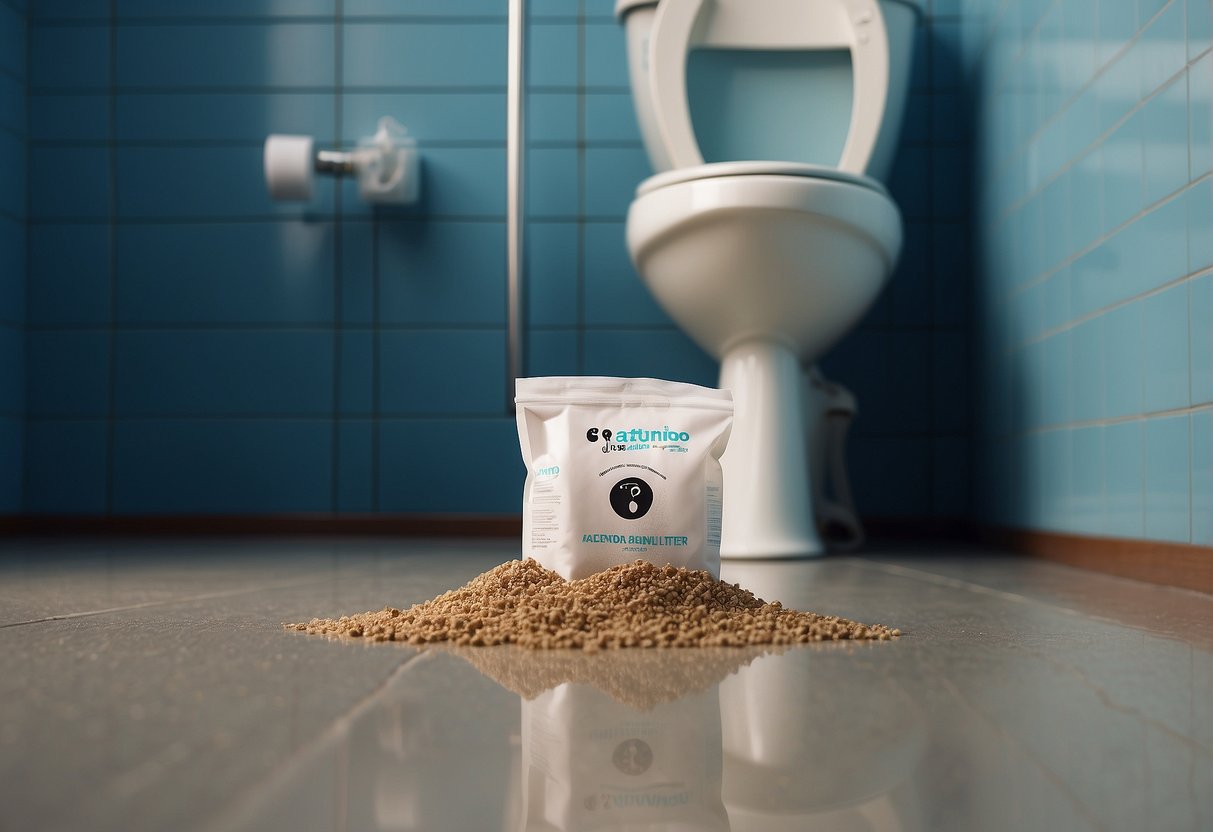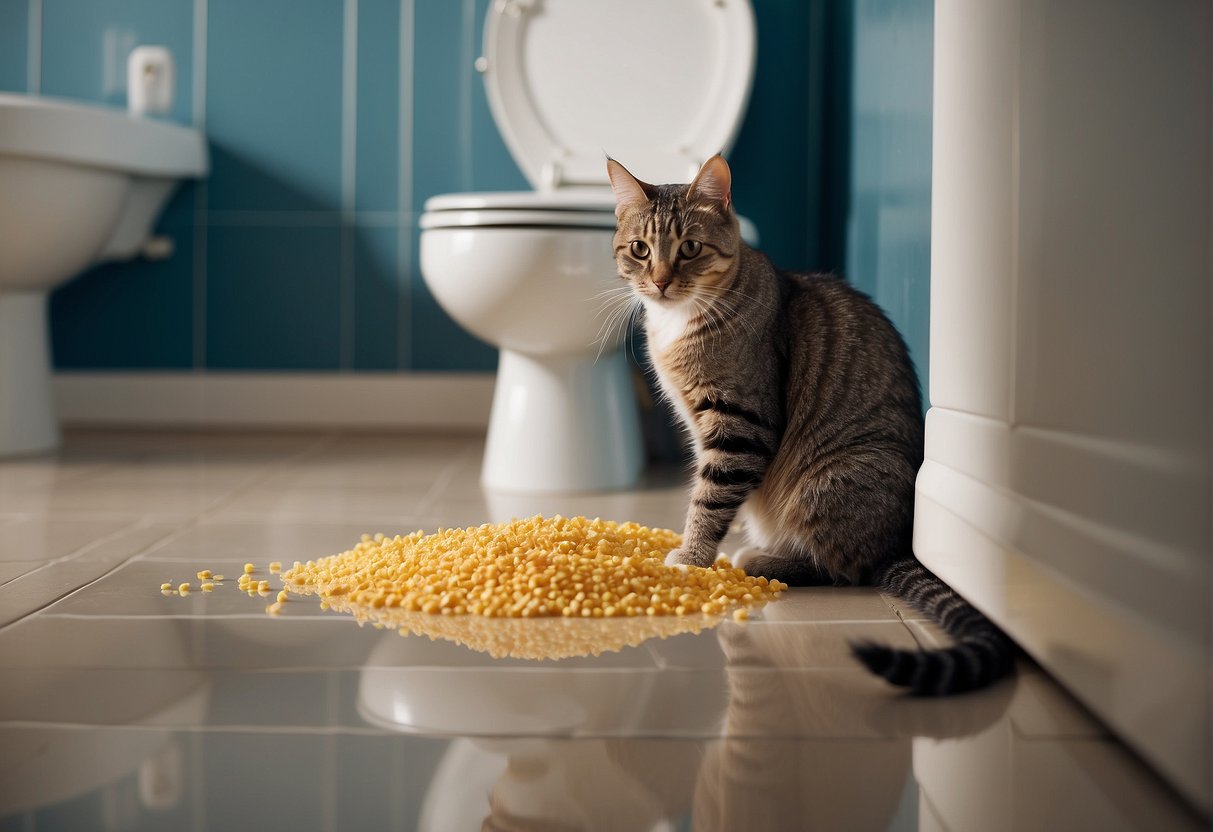Flushing cat litter down the toilet may seem like a convenient way to dispose of your cat’s waste, but it’s not typically recommended, even if the litter is labeled as flushable. Some eco-conscious brands have developed flushable litters made from biodegradable materials, such as corn, wheat, and wood shavings, yet these can still pose problems.
While these materials are indeed more environmentally friendly than their clay-based counterparts, they can still cause blockages in your plumbing over time or be harmful to local waterways once they’ve passed through your household sewage system.

The Impact of this disposal method is crucial for keeping your plumbing free from clogs and for considering the environmental implications. Plumbing systems can vary, and what works in one household may not be suitable in another.
Despite manufacturers’ claims, no litter is truly flushable in the sense that it will never cause any issues; many municipal sewage systems are not designed to handle the potential clumping and expansion of cat litter, which is why many environmental and plumbing experts advise against it.
Cat owners are always looking for ways to minimize mess and odor in a way that’s also kind to the environment. It’s tempting to reach for flushable cat litter as a convenient solution—no more litter bags in the trash, no more carrying heavy containers out to the bin.
However, remember that your sewer system is much like a cat itself: it prefers certain things and might retaliate if you rub it the wrong way. To avoid any unpleasant consequences, stick to traditional disposal methods for your cat’s litter or consider other eco-friendly alternatives like compostable litter, which you can compost at home if you’re dealing with non-clumping, organic litters.
The Impacts of Flushing Cat Litter

When considering whether to flush cat litter, it’s important to be mindful of the potential impacts on plumbing systems, the environment, and health considerations related to pathogens like Toxoplasma gondii.
Effects on Plumbing Systems
Your Home’s Plumbing: Flushing cat litter, even those labeled as “flushable,” risks creating blockages within the intricate web of your household plumbing.
This can lead to clogged pipes or a damaged septic system. For septic tanks, the dense litter can amass and reduce the system’s efficiency, potentially causing a complete backup.
Professional Intervention: In some cases, the blockage can become so severe that a professional plumber is required to restore function. The United States Environmental Protection Agency (EPA) notes that flushing non-human waste can harm plumbing systems and should generally be avoided.
Environmental Concerns
Water Contamination: The consequences extend beyond your bathroom. Cat litter can contribute to the broader sewage system, leading to water contamination. Materials that don’t biodegrade easily, such as clay or silica, may accumulate in waterways, disrupting the local ecosystem.
Sustainable Alternatives: While some litters are marketed as environmentally friendly, often made from materials like corn, walnut shells, or recycled paper, it’s crucial to consider the overall impact.
Even biodegradable litter can carry pathogens into the watercycle, where they can affect wildlife and ecosystems.
Health Risks from Toxoplasma Gondii
Toxoplasmosis Transmission: Cat feces may contain Toxoplasma gondii, a parasite responsible for toxoplasmosis. When cat litter is flushed, there’s a risk of this parasite entering water systems, as treatment plants may not be equipped to eliminate it.
This presents a health risk to both humans and marine life.
Recommendations: The EPA advises against flushing cat litter to prevent the spread of Toxoplasma gondii. This is especially important in households with individuals who have weakened immune systems, as they are more susceptible to the effects of pathogens.
Flushable vs. Non-Flushable Litter
When you’re deciding on the best litter for your feline friend and your home, understanding the difference between flushable and non-flushable cat litter is crucial.
Evaluating Flushable Cat Litter
Flushable cat litters are typically made from sustainable materials like shredded newspaper, sawdust, corn kernels, walnut shells, or wheat enzymes. They are designed to break down in water, making them safe to dispose of via the toilet.
However, it’s essential to check the water waste regulations in your area because even biodegradable materials can potentially cause problems in certain plumbing systems or conflict with local municipal codes.
Some of the environmentally friendly options, like sWheat Scoop, are made from domestically sourced wheat and are praised for their biodegradable nature and odor control, particularly in multi-cat households.
The Reality of ‘Flushable’ Labels
Just because a label says ‘flushable’ doesn’t always mean it’s the right choice for every home or plumbing system. You should be aware that the term “flushability” can vary; not all flushable litters work equally well with all types of plumbing, especially if you have a septic system.
While natural cat litters marketed as flushable are designed to disintegrate in water, clay-based litter is a non-flushable type that must be disposed of in the trash as it can clump and block pipes. It’s a good rule of thumb to test flushable litter in small amounts at first if you’re considering this option for your cat.
Eco-Friendly Alternatives and Practices
Embracing eco-friendly options can significantly lessen the environmental pawprint of your feline friend. Let’s explore practical and sustainable methods to dispose of cat litter that can also benefit the planet.
Composting and Biodegradable Bags
Composting is a fantastic way to deal with used cat litter, provided it’s made from biodegradable materials like paper, wood, or wheat. By composting, you not only reduce waste in landfills but also create a nutrient-rich soil amendment for your non-edible plants.
Remember to only compost cat litter if the product is marked as compostable and to use specifically designed biodegradable bags that break down efficiently in the environment.
- Pro Tip: Not all litters are safe to compost, especially when dealing with waste from indoor cats, due to potential pathogens. Always check the packaging for composting guidelines.
Litter Disposal Tips
Proper disposal of cat litter is crucial to maintain sustainability. Instead of flushing or tossing in the trash, consider eco-friendly cat litter that can be either composted or disposed of in biodegradable bags. This helps minimize the impact on landfills and promotes a more sustainable cycle.
- Remember: Sustainable materials like recycled paper or wheat litter can offer green alternatives without compromising on effectiveness.
Innovative Litter Box Solutions
The market is ripe with ingenious solutions to make your life easier and greener. For example, a recycled litter boxpaired with World’s Best Cat Litter or Garfield Cat Litter, which are known for their natural and biodegradable properties, can offer a great way to align your cat’s needs with ecological values.
Also, innovative sifting litter boxes allow you to separate waste from clean litter, reducing the amount of litter that needs to be replaced or disposed of.
- Eco Fact: Opting for litters made from sustainable materials can significantly cut down on the traditional clay-based litters that do not biodegrade.

My name is James, and welcome to FAQCats!
Along with our team of cat owners, expert pet enthusiasts, and pet professionals, we aim to write engaging helpful, engaging content about cats. At FAQCats we strive to provide content that’s accurate and fun to read. Our team writes about everything related to cats; even the most complex of topics. Through extensive research and caring for our own fur-pals, we’re able to provide something cat owners worldwide will love. Have a look around, and leave us feedback anytime!

